C高级第三次作业
C高级第三次作业(1)
6-1 输出月份英文名


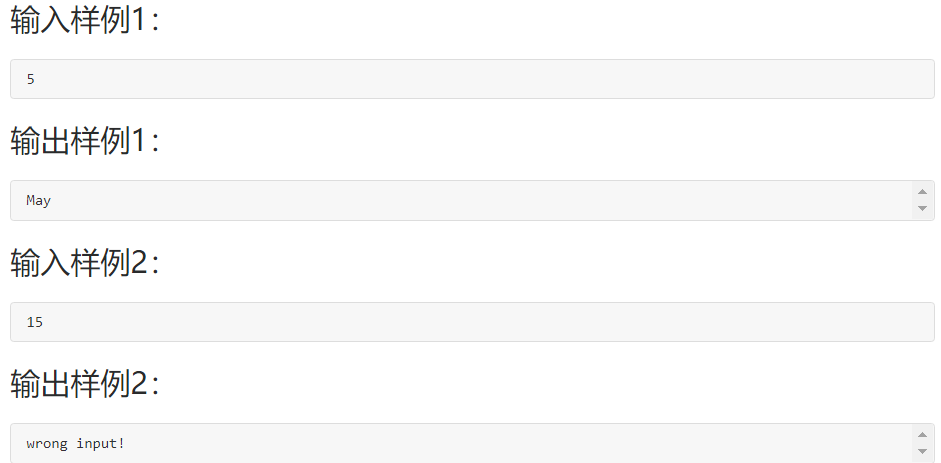
1.设计思路
(1)算法:
第一步:定义整型变量n,字符指针s,输入一个数赋给n。
第二步:调用函数getmonth将值赋给s。
第三步:在函数getmonth中使用switch—case语句来实现,返回月份的英文名。
第四步:在主函数中如果s==NULL就输出wrong input,否则输出s。
(2)流程图:
2.实验代码:
char *getmonth( int n ){char *a;switch(n){case 1:strcpy(a,"January");break;case 2:strcpy(a,"February");break;case 3:strcpy(a,"March");break;case 4:strcpy(a,"April");break;case 5:strcpy(a,"May");break;case 6:strcpy(a,"June");break;case 7:strcpy(a,"July");break;case 8:strcpy(a,"August");break;case 9:strcpy(a,"September");break;case 10:strcpy(a,"October");break;case 11:strcpy(a,"November");break;case 12:strcpy(a,"December");break;default:strcpy(a,"NULL");}return(a);}
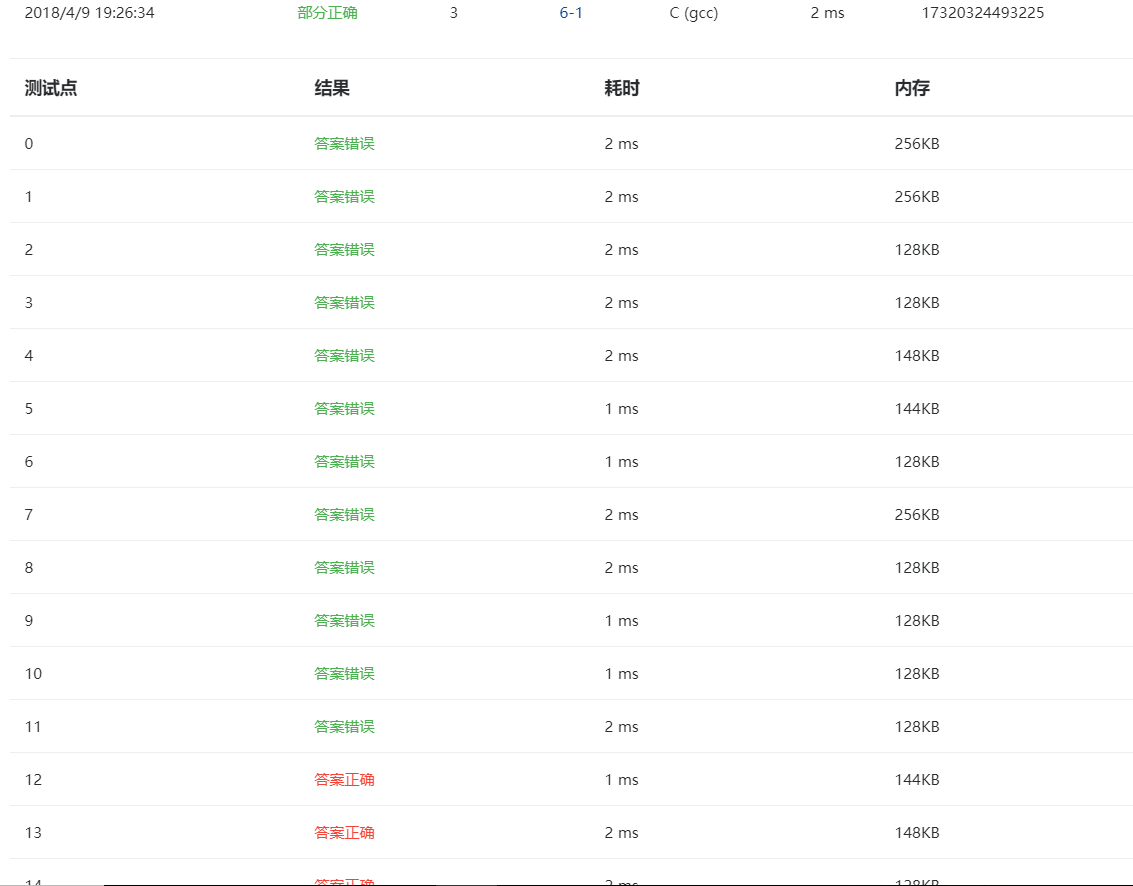
修改后的代码
char *getmonth( int n ){switch(n){case 1:return "January";case 2:return "February";case 3:return "March";case 4:return "April";case 5:return "May";case 6:return "June";case 7:return "July";case 8:return "August";case 9:return "Septemer";case 10:return "October";case 11:return "November";case 12:return "December";default:return NULL;}}

3.本题调试过程碰到问题及解决办法:
问题1:部分正确
错误的原因:没有声明string函数库,无法调用strcpy函数。
修正方法:自己想不出来在网上搜解题思路,自己重新写。
6-2 查找星期


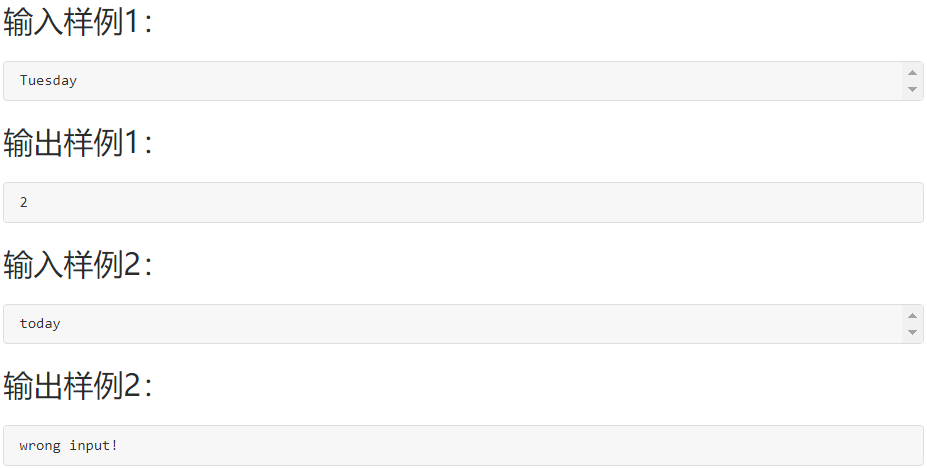
1.设计思路:
(1)算法:
第一步:定义整型变量i,字符数组s[MAXS],输入一个字符串赋给s。
第二步:调用函数getindex,n=getindex的返回值。
第三步:在getindex函数中,定义整型变量a=-1,i=0,字符指针数组*week[7]={"Sunday","Monday","Tuesday","Wednesday","Thursday","Friday","Saturday"},定义字符型指向指针的指针**p=week在for循环中i为循环变量,条件为i<7,如果strcmp(s,week[i])0,就执行a=i,然后跳出这个循环,执行完for循环最后返回a。
第四步:在主函数中如果n-1,就执行wrong input!,否则就输出n的值
(2)流程图:

2.实验代码
int getindex( char *s ){int a=-1,i;char *week[7]={"Sunday","Monday","Tuesday","Wednesday","Thursday","Friday","Saturday"};char **p=week;for(i=0;i<7;i++){if(strcmp(s,*(p+i))==0){a=i;break;}}return a;}
3.本题调试过程碰到问题及解决办法:

6-3 计算最长的字符串长度


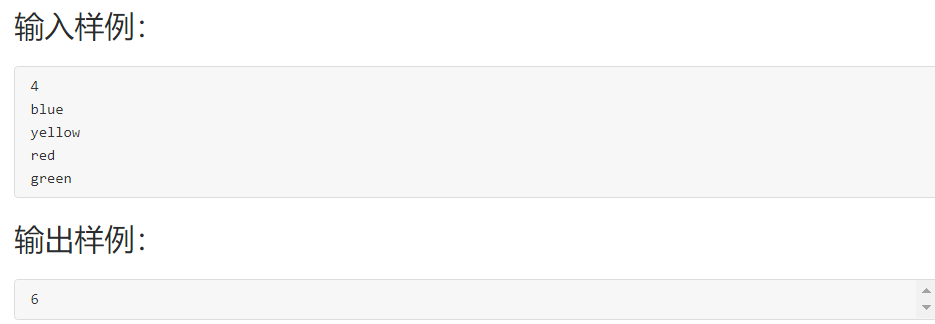
1.设计思路:
(1)算法:
第一步:常量MAXN 10,MAXS 20,定义整型变量i,n,字符指针数组string[MAXN] = {NULL},输入一个数赋给n。
第二步:借助for循环i=0;条件为i<n;在for循环中动态分配内存大小为20字节,输入一个字符串赋给string[i]。
第三步:调用max_len函数,将函数max_len的返回值输出。
第四步:在函数max_len中,定义整型变量i,count=0,j,整型数组q[20]={0};借助for循环求出(*(s+i))中的字符串的长度,将值赋给q[i];
第五步:count=q[0],借助for循环找到q[i]的最大值赋给count,最后返回count的值。
(2)流程图

2.实验代码:
int max_len( char *s[], int n ){int i,count=0,j,q[20]={0};for(i=0;i<n;i++){for(j=0;*(*(s+i)+j)!='\0';j++){}q[i]=j;}count=q[0];for(i=0;i<n;i++){if(q[i]>count){count=q[i];}}return count;}
3.本题调试过程碰到问题及解决办法:

6-4 指定位置输出字符串
1.设计思路
(1)算法:
第一步:定义字符数组str[10],字符变量ch_start, ch_end,字符型指针变量p,
第二步:独树一格字符串给str,读入两个字符分别赋给ch_start, ch_end,
第三步:调用函数match,将函数的返回值赋给p。
第四步:在函数match中定义整型变量i,j,字符型指针q=NULL,i=0,借助for循环条件为(s+i)!='\0',在for循环中如果(s+i)==ch1,定义字符型指针a=&s[i],j=i,借助for循环条件为((s+j)!=ch2)&&((s+j)!='\0'),输出字符(s+j),执行完第二个for循环判断如果(s+j)!='\0',就输出字符(s+j),并且换行,返回a的地址,执行完第一个for循环直到条件不满足,就换行并且返回q的地址。
第五步:输出字符串p。
(2)流程图:
2.实验代码:
char *match( char *s, char ch1, char ch2 ){int i,j;char *q=s;for(i=0;*(s+i)!='\0';i++){if(*(s+i)==ch1){for(j=i;*(s+j)!=ch2;j++){*(q)=*(s+j);q++;}*q=ch2;}}*q='\0';printf("%s\n",q);}
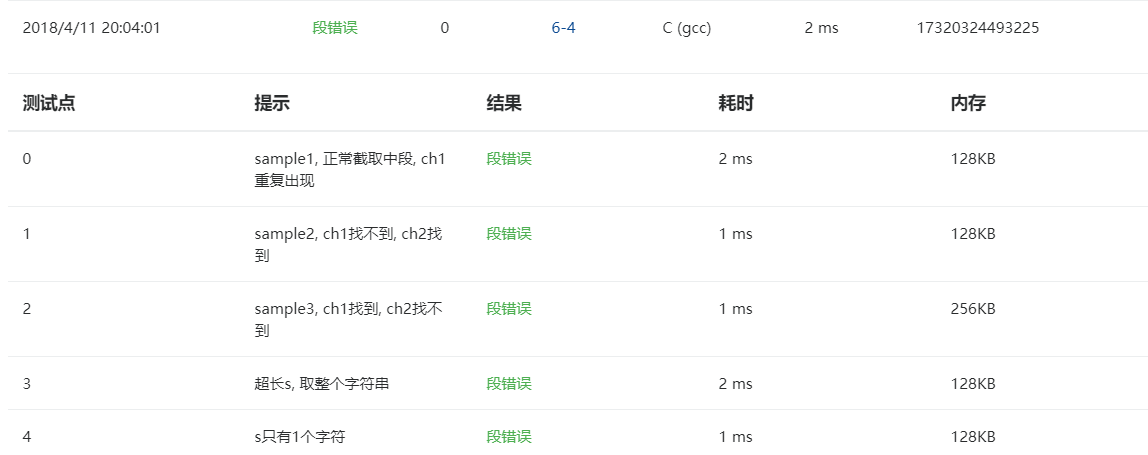
修改后的代码:
char *match( char *s, char ch1, char ch2 ){int i,j;char *q=NULL;for(i=0;*(s+i)!='\0';i++){if(*(s+i)==ch1){char *a= &s[i];for(j=i;(*(s+j)!=ch2)&&(*(s+j)!='\0');j++){printf("%c",*(s+j));}if(*(s+j)!='\0')printf("%c",*(s+j));printf("\n");return a;}}printf("\n");return q;}

在修改后的代码:
char *match( char *s, char ch1, char ch2 ){int i,j;char *q=NULL;for(i=0;*(s+i)!='\0';i++){if(*(s+i)==ch1){char *a= &s[i];for(j=i;(*(s+j)!=ch2)&&(*(s+j)!='\0');j++){printf("%c",*(s+j));}if(*(s+j)!='\0')printf("%c",*(s+j));printf("\n");return a;}}printf("\n");return s+i;}
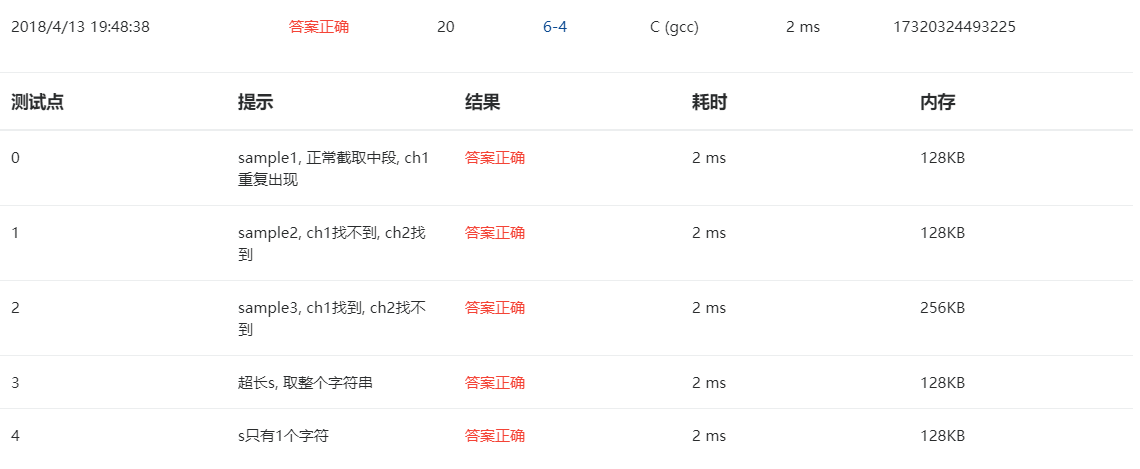
3.本题调试过程碰到问题及解决办法:
错误信息1:段错误
错误原因:自己没有读懂题意就写代码,一方面自己最后只是输出两个字符之间的所有字符,另一方面当函数找不到时返回得值不值空指针,代码不能满足所有的测试点。
改正方法:在一开始就定义指针为空指针,当找到的的话就重新定义一个指针,他的值为ch1的地址,输出在两个字符之间的所有字符,输出完换行并且返回指针变量,没有找到,就换行并且返回空指针。
错误信息2:部分正确有一个测试点错误
错误原因:在最后的返回值返回的是空指针原来返回的是q空指针
改正方法:将返回值改成s+i
码云代码存放:

C高级第三次作业(2)
6-1 奇数值结点链表




1.设计思路
(1)算法:
第一步:声明结构体类型,整型变量data,结构体指针变量next
第二步:在主函数中,定义结构体指针变量L,Odd,调用函数readlist将函数的返回值给L,调用函数getodd,将函数的返回值给Odd,
第三步:在readlist函数中,定义结构体指针变量head=NULL,p=NULL,q=NULL,整型数data,对p,q动态分配内存类型强制转化为结构体指针,大小为sizeof(struct ListNode),读入一个书给p->data,使用while语句条件为p->data!=-1,在循环语句中如果headNULL,head=p,否则q->next=p,在if语句结束之后q=p,在对p动态分配内存类型强制转化为结构体指针,大小为sizeof(struct ListNode),读入一个数给p->data,在执行完while语句后q->next=NULL,返回head。
第四步:在getodd函数中,定义结构体指针变量head=NULL,q=NULL,p,w=NULL,head1=NULL,如果L!=NULL就执行for循环,for循环条件1为head=*L,条件2为head!=NULL,条件3为head=head->next,在for循环中如果head->data%2!=0执行head1=head,否则执行p->next=head,在if语句之后p=head,如果head->data%2!=0不满足,就执行如果qNULL,q=head,否则w->next=head,在if语句之后执行w=head,执行完for循环后p->next=NULL,如果w!=NULL执行w->next=NULL。最后*L=q。在第一个if不满足时返回NULL,在最后返回head1.
第五步:两次调用函数printlist,将奇数和偶数的链表分别打印出来。
(2)流程图:
2.实验代码:
struct ListNode *readlist(){struct ListNode *head=NULL,*p=NULL,*q=NULL;int data;p=q=(struct ListNode *)malloc(sizeof(struct ListNode));scanf("%d",&p->data);while(p->data!=-1){if(head==NULL){head=p;}else{q->next=p;}q=p;p=(struct ListNode *)malloc(sizeof(struct ListNode));scanf("%d",&p->data);}return head;}struct ListNode *getodd( struct ListNode **L ){struct ListNode *head=NULL,*q=NULL,*p,*w=NULL,*head1=NULL;if(*L!=NULL){for(head=*L;head!=NULL;head=head->next){if(head->data%2!=0){if(head1==NULL){head1=head;p=head1;}else{e->next=p;}for(q=*L;q->data%2==0&&q->next!=NULL;q=q->next){w=q;}if(q->data%2!=0){if(q=*L){*L=q->next;}else{w->next=q->next;}}//}}w->next=NULL;}else{return NULL;}e->next=NULL;return head1;}

修改后的代码:
struct ListNode *readlist(){struct ListNode *head=NULL,*p=NULL,*q=NULL;int data;p=q=(struct ListNode *)malloc(sizeof(struct ListNode));scanf("%d",&p->data);while(p->data!=-1){if(head==NULL){head=p;}else{q->next=p;}q=p;p=(struct ListNode *)malloc(sizeof(struct ListNode));scanf("%d",&p->data);}q->next=NULL;return(head);}struct ListNode *getodd( struct ListNode **L ){struct ListNode *head=NULL,*q=NULL,*p,*w=NULL,*head1=NULL;if(*L!=NULL){for(head=*L;head!=NULL;head=head->next){if(head->data%2!=0){if(head1==NULL){head1=head;}else{p->next=head;}p=head;}else{if(q==NULL){q=head;w=q;}else{w->next=head;}}}p->next=NULL;if(w!=NULL)w->next=NULL;*L=q;}else{return NULL;}return(head1);}
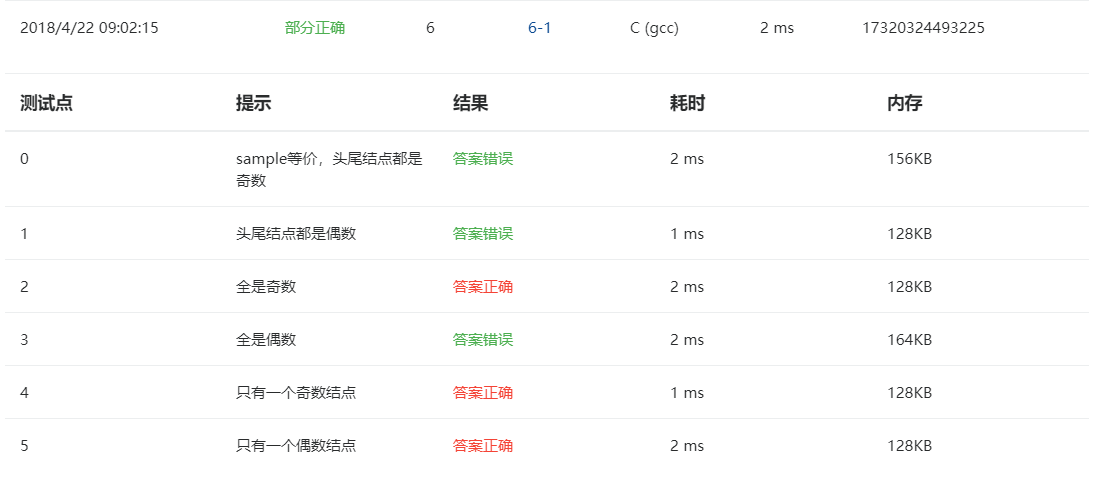
再次修改
struct ListNode *readlist(){struct ListNode *head=NULL,*p=NULL,*q=NULL;int data;p=q=(struct ListNode *)malloc(sizeof(struct ListNode));scanf("%d",&p->data);while(p->data!=-1){if(head==NULL){head=p;}else{q->next=p;}q=p;p=(struct ListNode *)malloc(sizeof(struct ListNode));scanf("%d",&p->data);}q->next=NULL;return(head);}struct ListNode *getodd( struct ListNode **L ){struct ListNode *head=NULL,*q=NULL,*p,*w=NULL,*head1=NULL;if(*L!=NULL){for(head=*L;head!=NULL;head=head->next){if(head->data%2!=0){if(head1==NULL){head1=head;}else{p->next=head;}p=head;}else{if(q==NULL){q=head;}else{w->next=head;}w=head;}}p->next=NULL;if(w!=NULL)w->next=NULL;*L=q;}else{return NULL;}return(head1);}
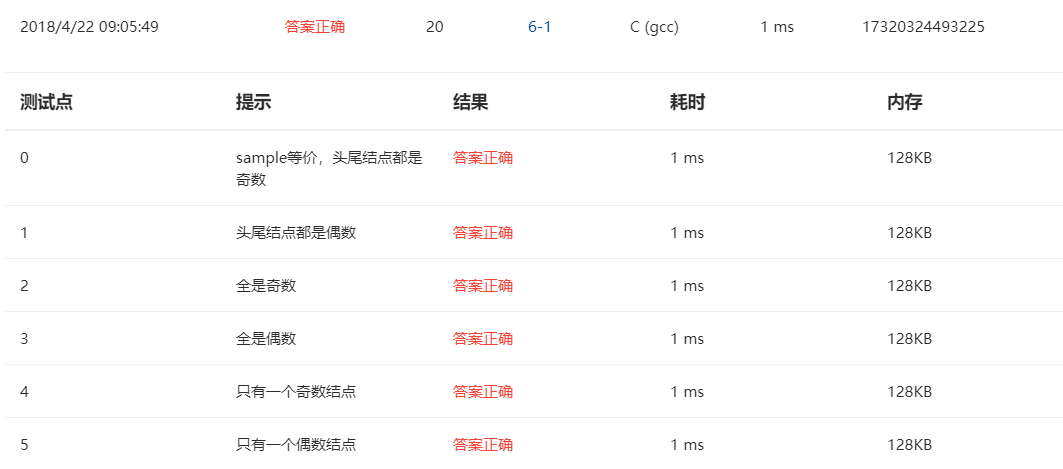
3.本题调试过程碰到问题及解决办法:
错误信息1:
错误的原因:调试的过程中知道1在建立链表时没将最后一个节点的值赋值为NULL。2.p的地址一直都是head1的起始地址,没有将p的地址变化
修改方法在建立链表的函数中最后加上p->next=NULL,在getodd函数中p=head。
错误信息2.
错误原因:同样的问题w的地址一直都是q的起始地址没有叫它改变,
改正方法:使w=head。
6-2 学生成绩链表处理


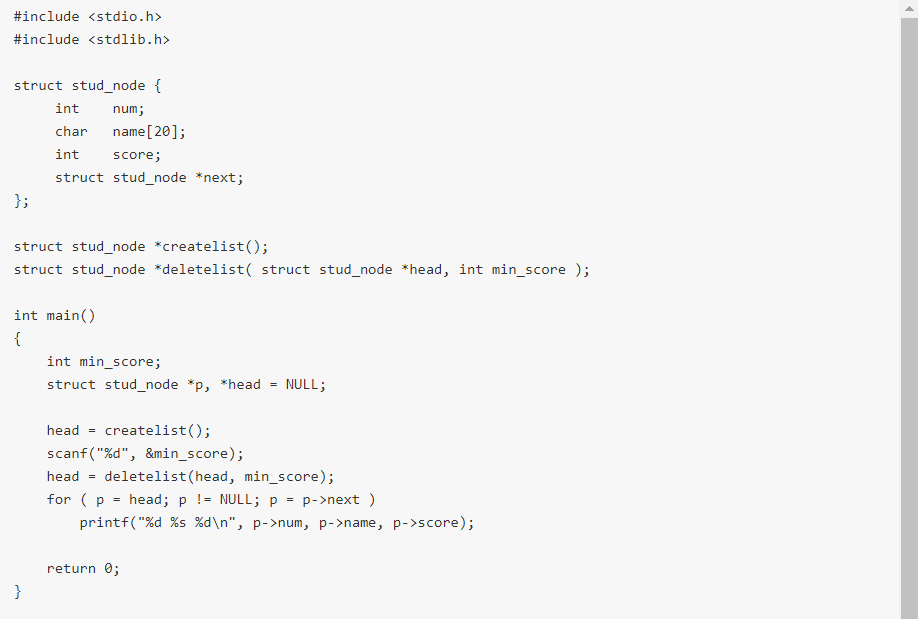

1.设计思路
(1)算法
第一步:声明结构体类型,整型数num,字符数组name[20],整型数score结构体指针变量next,
第二步:主函数中,定义整型min_score,结构体指针变量p,head=NULL,调用函数creatlist,将creatlist的返回值赋给head,
第三步在creatlist函数中,定义结构体指针变量head,p=NULL,q=NULL,对p和q动态分配内存类型强制转化为结构体指针,大小为sizeof(struct stud_node),读入一个数赋给p->num,使用while循环条件为p->num!=0,在循环体中,读入一个字符串和整型数字给p->name和p->score,如果headNULL,head=p,否则q->next=p。if语句结束执行q=p 在对p动态分配内存类型强制转化为结构体指针,大小为sizeof(struct stud_node),,读入一个数赋给p->num,当while天剑不满足时执行q->next=NULL,返回head给主函数
第四步:在主函数中输入一个数给min_score,调用函数deletelist,将函数的返回值给head,
第五步:定义结构体指针变量p,q,*w,使用if语句,条件为head!=NULL,借助for循环条件1为w=head,条件2为w!=NULL条件3为w=w->next,在循环体中借助if语句条件为w->score<min_score,借助for循环条件1为p=head条件2为min_score<=p->score&&p->next!=NULL条件3为p=p->next,在循环体中执行q=p。直到结束使用if语句条件min_score>p->score,在判断语句中使用if语句条件为phead执行head=p->next否则执行q->next=p->next,在第一个if语句不满足时返回NULL,最后返回head
第六步:打印链表head,
(2).流程图:
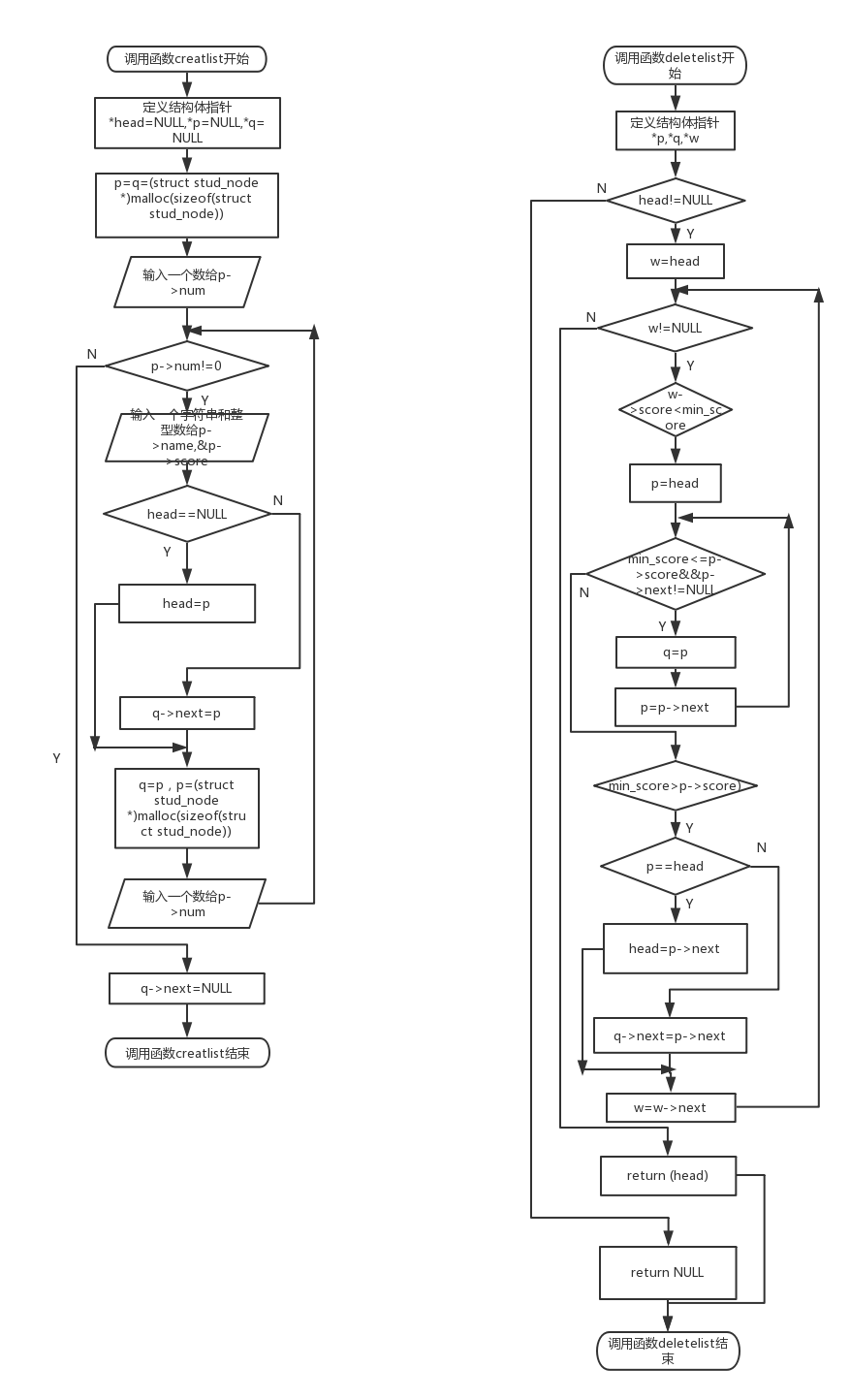
2.实验代码
struct stud_node *createlist(){struct stud_node *head=NULL,*p=NULL,*q=NULL;p=q=(struct stud_node *)malloc(sizeof(struct stud_node));int num;char name[20];int score;scanf("%d",&p->num);while(p->num!=0){scanf("%s %d",p->name,&p->score);if(head==NULL){head=p;}else{q->next=p;}q=p;p=(struct stud_node *)malloc(sizeof(struct stud_node));scanf("%d",&p->num);}q->next=NULL;return (head);}struct stud_node *deletelist( struct stud_node *head, int min_score ){struct stud_node *p,*q,*w;int i;if(p!=NULL){for(w=head;w!=NULL;w=w->next){p=head;while(min_score<=p->score&&p->next!=NULL){q=p;p=p->next;}if(min_score>p->score){if(p==head){head=p->next;}else{q->next=p->next;}}}}return (head);}

修改后的代码
struct stud_node *createlist(){struct stud_node *head=NULL,*p=NULL,*q=NULL;p=q=(struct stud_node *)malloc(sizeof(struct stud_node));scanf("%d",&p->num);while(p->num!=0){scanf("%s %d",p->name,&p->score);if(head==NULL){head=p;}else{q->next=p;}q=p;p=(struct stud_node *)malloc(sizeof(struct stud_node));scanf("%d",&p->num);}q->next=NULL;return (head);}struct stud_node *deletelist( struct stud_node *head, int min_score ){struct stud_node *p,*q,*w;if(head!=NULL){for(w=head;w!=NULL;w=w->next){if(w->score<min_score){for(p=head;min_score<=p->score&&p->next!=NULL;p=p->next){q=p;}if(min_score>p->score){if(p==head){head=p->next;}else{q->next=p->next;}}}}return (head);}else{return NULL;}}

3.本题调试过程碰到问题及解决办法:
错误信息1
错误原因:只删除一个不满足条件的节点。
改正方法,使用for循环每找到一个不满足条件的就执行一次删除操作。
6-3 链表拼接
1.设计思路:
(1)算法:自己的思路有问题;
(2)流程图
2.实验代码:
struct ListNode *mergelists(struct ListNode *list1, struct ListNode *list2){struct ListNode *head,*p,*q;int a[10],i=0;for(p=list1;p!=NULL;p=p->next){a[i++]=p->data;}for(p=list2;p!=NULL;p=p->next){a[i++]=p->data;}int j,n,k,temp;n=i;for(i=0;i<n-1;i++){k=i;for(j=i;j<n;j++){if(a[j]<a[k]){j=k;}}if(k!=i){temp=a[i];a[i]=a[k];a[k]=temp;}}for(i=0;i<n;i++){p->data=a[i];if(head==NULL){head=p;}else{q->next=p;}q=p;}q->next=NULL;return head;}
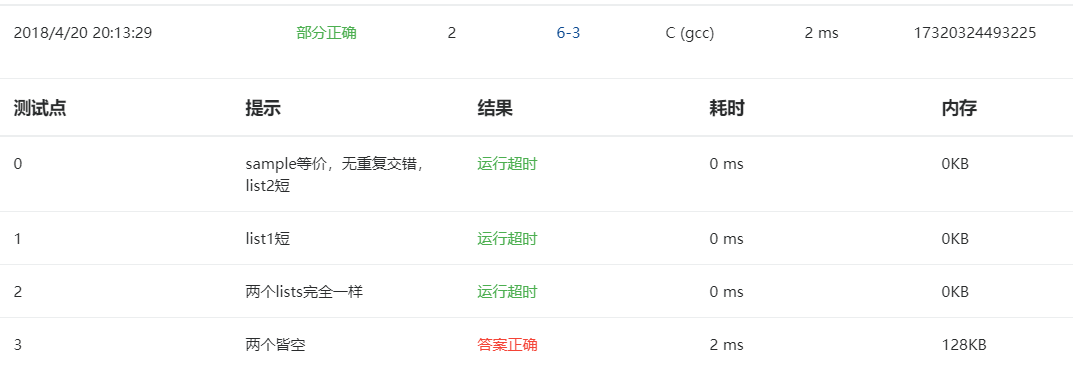
3.本题调试过程碰到问题及解决办法:
错误信息1:
错误原因:考虑不全面
改正方法:不会。
博客上的题目

实验代码:
#include <stdio.h>#include <stdlib.h>#include <math.h>long *zhishu(long *p,int a,int b);void print(long *p,int a,int b);int main(){int a=201,b=3936,i,j;long n[a*b],*p;for(i=0;i<a;i++){for(j=0;j<b;j++){n[(i+1)*(j+1)]=(i+1)*(j+1);}}p=zhishu(n,a,b);print(p,a,b);return 0;}long *zhishu(long *p,int a,int b){int i,j,c=2,d=0;long *q=p;j=a*b;for(i=0;i<j&&c<=sqrt(a*b);i++){d=0;if(*(q+i)!=1){if(*(q+i)%c!=0){q[d++]=*(q+i);}}j=d;c=q[0];}return q;}void print(long *p,int a,int b){int i;for(i=0;*(p+i)<=a*b;i++){if((i+1)%5!=0){printf("%ld ",*(p+i));}else{printf("%ld\n",*(p+i));}}}
运行出错,不会写
修改后的代码:
#include <stdio.h>#include <stdlib.h>#define N 20#define M 39void delete(int s[N][M],int x);int main(){int i,j,a[N][M],num=1;for(i=0;i<N;i++){for(j=0;j<M;j++){a[i][j]=num;num++;}} //创建一个二维数组,元素从1 到N*Ma[0][0]=0; //a[0][0]=1不是质数,将它赋值为0for(i=0;i<N;i++){for(j=0;j<M;j++){if(a[i][j]!=0){delete(a,a[i][j]); //调用函数进行筛选法 ,每调用函数一次数组a,a的值都会发生变化,不是质数的元素赋值为0}}}for(i=0;i<N;i++){for(j=0;j<M;j++){if(a[i][j]!=0){printf("%d\t",a[i][j]);}}} //将所有的指数(数组中不为0的数)输出return 0;}void delete(int s[N][M],int x){int i,j;for(i=0;i<N;i++){for(j=0;j<M;j++){if(i!=0||j!=0){ //跳过a[0][0],if(s[i][j]%x==0&&s[i][j]!=x){s[i][j]=0;//将所有的能被想整除的数赋值为0}}}}}
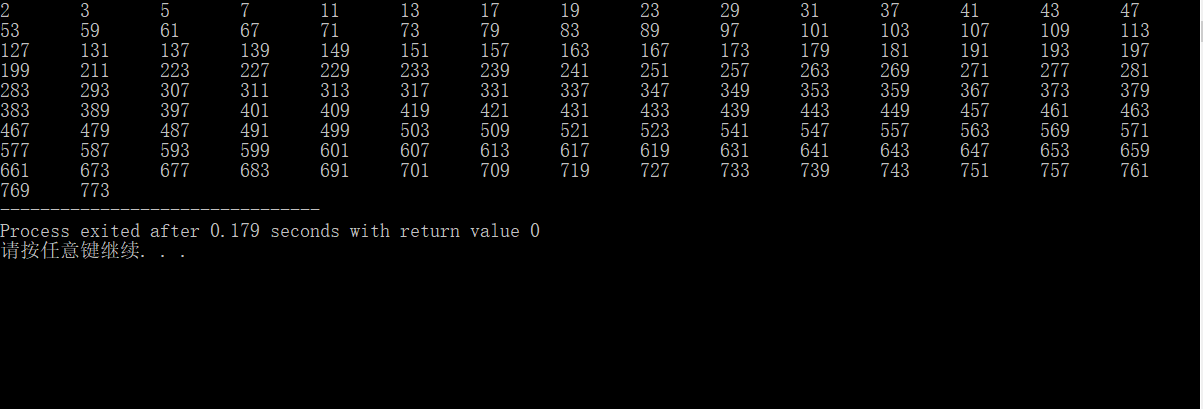
反思:
1.在做题之前好好读题,要读懂题的意思
2.不要固定自己的思维,一种方法不可以,可以换个方法。
3.当出现问题的时候,不要抱怨,自暴自弃,要多想一想


代码存放:
git
评论我的博客同学:
姜健https://i.cnblogs.com/EditPosts.aspx?postid=8778302
陆文奇:https://i.cnblogs.com/EditPosts.aspx?postid=8778302
党睿:https://i.cnblogs.com/EditPosts.aspx?postid=8778302
辛静瑶:https://i.cnblogs.com/EditPosts.aspx?postid=8778302
我所评论的同学:
姜健:http://www.cnblogs.com/jj990519/p/8763063.html
袁中:http://www.cnblogs.com/2719610441qqcom/p/8762037.html
王姝雯:http://www.cnblogs.com/phsudie/p/8759331.html
党睿:http://www.cnblogs.com/dangrui/p/8797836.html
辛静瑶:http://www.cnblogs.com/X-JY/p/8761685.html
知识点总结:
char *name[]={"Follow me","BASIC",......}
指针数组相当于二维数组;
name ——>二维数组的首元素的地址 =name[0]——>行指针——>第0行首元素的地址/第0个字符串的起始地址
name[1]——>行指针——>第一行首元素的地址 /第一个字符串的起始地址
*name——>列指针——>第0行第0列元素的地址/指向第0个字符串的第0个字符的地址
*(name+1)——>列指针——>第一行第0列元素的地址/指向第一个字符串的第0个字符的地址。
*(name+i)+n >第i行第n列元素的地址
((name+i)+n)>第i行第n列元素的值 例如 ((name+1)+1)=‘A’
链表其实就是结构递归定义,有一个头指针变量,还有表尾,表尾的地址部分放一个NULL表示链表结束。
形式
struct student{
int num;
float score;
......
struct student *next; //最主要的
};
在链表中要使用动态分配内存
malloc函数,malloc函数的返回值是一个分配域的起始地址
在链表中形式为:p=(struct student *)malloc(sizeof struct student );
对链表的操作:建立动态链表、输出、插入、删除;
建立链表的函数:
struct student *creat(void){struct student *head=NULL,*p=NULL,*q=NULL;p=q=(struct student *)malloc(sizeof(struct student));scanf("%d",&p->num);while(p->num!=0){if(head==NULL)head=p;else q->next=p;q=p;p=(struct student *)malloc(sizeof(struct student));scanf("%d",&p->num);}q->next=NULL;return(head);}
输出链表:
void print(struct student *head){struct student *p;for(p=head;p!=NULL;p=p->next){printf("%d %f ...."p->num,p->score,.....);}}
删除节点:
struct student *deleatstruct student *head,int num){struct student *p,*q;if(head!=NULL){for(p=head;p->next!=NULL&&p->num!=num;p=p->next){q=p;}if(p->num==num){if(p==head)head=p->next;else q->next=p->next;}}else{printf("没有找到");}return(head);}
插入节点:
struct student *insert(struct student *head,struct student *stud){struct student *p,*q;if(head!=NULL){for(p=head;p->num!=stud->num&&p->next!=NULL;p=p->head){q=p;}if(p->num==stud->num){if(p==head){head=stud;stud->next=p;}else{q->next=stud;stud->next=p;}}else{p->next=stud;stud->next=NULL}}return(head);}
C高级第三次作业的更多相关文章
- C高级第三次作业(1)
6-1 输出月份英文名 1.设计思路: 1.定义一个字符串数组将12个月的英文加进去: 2.判断输入的数是否大于等于1小于等于12: 3.若是 则返还s[n-1]; 4.否则返还NULL: 源代码: ...
- 软件工程(QLGY2015)第三次作业点评(含成绩)
相关博文目录: 第一次作业点评 第二次作业点评 第三次作业点评 团队信息 本页点评团队1-22,其他组见:http://www.cnblogs.com/xiaozhi_5638/p/4490764.h ...
- 2018上C语言程序设计(高级)博客作业样例
要求一(20分) 完成PTA中题目集名为<usth-C语言高级-第1次作业>中的所有题目. 要求二 PTA作业的总结(20分+30分) 将PTA第1次作业作业中以下2道题的解题思路按照规定 ...
- C程序第三次作业
6-1 输出月份英文名 PTA提交列表: 1.设计思路 (1)主要描述题目算法 第一步:将十二个月的名称分别赋值给一维数组指针,定义用于返回的数据类型. 第二步:遍历数组,满足若n在1-12范围则将m ...
- C语言——第三次作业(2)
作业要求一 PTA作业的提交列表 第一次作业 第二次作业 一道编程题: 有一个axb的数组,该数组里面顺序存放了从1到a*b的数字.其中a是你大学号的前三位数字,b是你大学号的后四位数字,比如你的学号 ...
- C高级第二次PTA作业
6-7 删除字符串中数字字符 1.设计思路: (1)算法: 第一步:定义一个字符数组item,输入一个字符串赋给字符数组item.调用函数delnum, 第二步:在函数delnum中定义循环变量i=0 ...
- C语言--第三次作业
要求一 . 1)C高级第三次PTA作业(1) 题目6-1 1.设计思路 (1)主要描述题目算法 第一步:将月份分别赋值: 第二步:利用switch语句,输 ...
- 北航OO第三单元作业总结(3.1~3.3)
JML简介及相关工具链使用 1.JML规格描述语言介绍 本单元学习的内容是JML规格描述语言.我们知道,面向对象方法是一个抽象过程,需求者仅需关注方法的规格.规格是对一个方法/类/程序的外部可感知行为 ...
- 2003031121-浦娟-python数据分析第三周作业-第一次作业
项目 内容 课程班级博客链接 https://edu.cnblogs.com/campus/pexy/20sj 作业链接 https://edu.cnblogs.com/campus/pexy/20s ...
随机推荐
- IDA 逆向工程 反汇编使用
IDA pro 7.0版本 from:freebuf 用到的工具有IDA pro 7.0 ,被反汇编的是百度云(BaiduNetdisk_5.6.1.2.exe). 首先,IDA pro的长相如下: ...
- APP安全防护基本方法(混淆/签名验证/反调试)
本教程所用Android Studio测试项目已上传:https://github.com/PrettyUp/SecTest 一.混淆 对于很多人而言是因为java才接触到“混淆”这个词,由于在前移动 ...
- Qt之获取子部件
Qt5.10 QList<QObject*> list_children = this->children(); for(int i=0;i<list_children.siz ...
- 由于 Exception.tostring()失败,因此无法打印异常字符串
console程序执行错误时,不显示异常信息. 解决方法: 在命令行修改显示字符格式 chcp 936
- js简单验证码的生成和验证
如何用js生成简单验证码,并验证是否正确的方法 1.html页面如下 <div> <table border="0" cellspacing="5&qu ...
- linux下crontab的原理和用法
linux 系统则是由 cron (crond) 这个系统服务来控制的.Linux 系统上面原本就有非常多的计划性工作,因此这个系统服务是默认启动的.另 外, 由于使用者自己也可以设置计划任务,所以, ...
- 【框架】PageObject(一)
1.目的:为了将元素的find方法和业务逻辑分开来.如果元素的页面位置发生了变化,只需改动一个文件,而不影响业务的实现. 2.原理:一般一个页面对应一个class,在class里描述所有要用到的web ...
- LY.JAVA面向对象编程.工具类中使用静态、说明书的制作过程、API文档的使用过程
2018-07-08 获取数组中的最大值 某个数字在数组中第一次出现时的索引 制作说明书的过程 对工具类的使用 获取数组中的最大值 获取数字在数组中第一次出现的索引值 API的使用过程 Math
- R语言常用操作
1 取整运算 在编程实现的时候有时会碰到对数值取整的需求,而取整的方式却多种多样,依赖于具体问题,不过在R中已经配备了种类齐全的相关函数,主要包括以下五种: floor():向下取整: ceiling ...
- tomcat vue webpack vue-router 404
社区已经有结局方案了, http://blog.csdn.net/hayre/article/details/70145513
